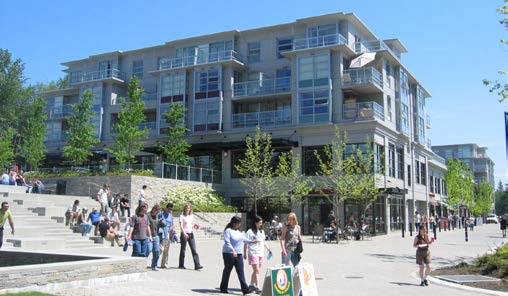Built Form Framework

The Built Form Framework provides a structure for new building development on campus, envisioned to be implemented over a 20 to 30 year horizon. It reflects the maximum build-out potential for the Campus in terms of building footprint, one that creates a well balanced ratio between buildings and open space. The Framework defines the desired character, location, orientation, quality, and massing of new buildings so that they are responsive to and enhance the Campus’ open spaces. It provides a built form context that delivers on creating a comfortable, human scale, pedestrian environment that offers a mix of uses to serve both the student and community population. The Framework identifies opportunities to increase the development capacity of the site, if needed, by identifying locations for increased height, guided by policies that define a respectful transition to the adjacent low density neighbourhood fabric. The Framework allows flexibility in architectural design and expression, as an opportunity to add to the University’s catalogue of unique buildings. The resultant buildings must support a quality environment, and positively contribute to achieving the Vision.
Specifically, the Built Form Framework identifies ten new building sites that form the Plan’s West and South Quadrants, preserving the existing fabric of the University’s heritage East Quadrant. In order to make this possible, the Plan consolidates surface parking into parking structures and below-grade parking in new buildings in order to create opportunities for new development. The new building sites serve various functions in the context of the Plan’s physical structure. They are organized to define, enhance, and integrate existing and proposed public realm space. They provide active frontages to animate, engage, and provide “eyes” on the Campus’ two streets, numerous pathways, and open spaces. They provide opportunities to increase the internal social gathering spaces, amenity spaces, and study areas, and to connect these places to areas external to the Campus.
The allocation of buildings focus on:
- Creating a frontage along 20th Street and framing the street so that it is more intimate and pedestrian friendly;
- Completing a frontage along Louise Avenue with new buildings to animate the street and define entry and gateway;
- Providing a gateway entrance at Princess Avenue and 20th Street;
- Providing an animated context around the south recreational field;
- Providing an address and frontage along Victoria Avenue; and
- Creating new opportunities for a mixture and diversity of uses on the Campus.
Note that in some cases the recommendations of the Built Form Framework may differ from the City of Brandon zoning by-law. In these cases the approval of the City (i.e. a Variance or Conditional Use) would be required to permit such deviations on a project-by-project basis.
Campus Structure
The orientation and placement of buildings is essential to creating a friendly environment and is an integral part of wayfinding to and within the Campus.
Frontages & Entrances
Buildings play a critical role in creating a welcoming, accessible, and safe environment by providing a face and eyes on the public realm.
Height, Scale & Massing
The height and massing of buildings must be carefully considered and situated because of the intimate scale of the Campus.
Views, View Corridors & Landmarks
Defined views and view corridors, and the integration of landmark building structures, landscaping, and art assists in campus wayfinding and building identity for the University.
Heritage Conservation
Brandon University has a collection of prominent older buildings that represent significant architectural moments in time.
Building Transparency
Building transparency in a campus context is important because it helps to create a safe environment, allowing visibility indoors and outdoors.
Materials and Architectural Character
Regardless of the building design or architectural era, BU has successfully maintained a consistency in materiality which has resulted in a cohesive look to the campus.
Climate Considerations
Brandon University, like many universities across Canada, has the greatest number of users primarily in the colder months of the year.
Loading and Servicing
The compact scale of the Campus and the priority for a pedestrian-oriented environment requires a more integrated strategy for the loading and servicing of buildings.
